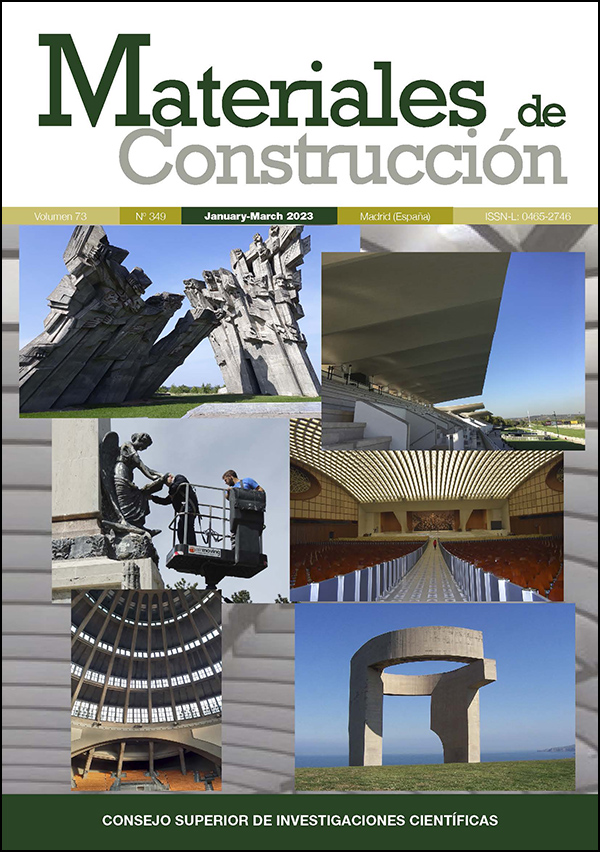Efecto de la composición mineralógica y granulometría de la escoria blanca de acería como un reemplazo de cemento/árido fino en hormigón
DOI:
https://doi.org/10.3989/mc.2023.301422Palabras clave:
Hormigón, Escoria blanca de acería, Propiedades mecánicas, Inestabilidad volumétrica, MicroestructuraResumen
La escoria blanca de acería (LFS) presenta potencial para ser valorizada. Sin embargo, su destino es ser depositada en vertedero, debido a barreras tecnológicas en su proceso de valorización. Este trabajo explora el potencial uso de LFS como reemplazo parcial de cemento/árido fino, enfocándose en los efectos de la composición y granulometría de LFS sobre propiedades físico-mecánicas. Se evalúa la composición química/mineralógica (muestras anhidras/hidratadas), propiedades en estado fresco/endurecido y ensayos de inestabilidad volumétrica en hormigón. Los resultados muestran un menor desempeño mecánico con el reemplazo de LFS, alcanzando 32-42 MPa de resistencia a compresión (28 días). La caracterización mineralógica de LFS revela la ausencia de CaO-libre y presencia de periclasa con sus productos de hidratación/carbonatación. Por lo tanto, el proceso de meteorización/maduración afecta principalmente a la CaO-libre. Además, la inestabilidad volumétrica observada se encuentra dentro de los límites establecidos por la EHE (0,04%), donde la periclasa remanente podría ser la responsable de este comportamiento expansivo.
Descargas
Citas
Schneider, M. (2019) The cement industry on the way to a low-carbon future. Cem. Concr. Res. 124, 105792. https://doi.org/10.1016/j.cemconres.2019.105792
Madlool, N.A.; Saidur, R.; Rahim, N.A.; Kamalisarvestani, M. (2013) An overview of energy savings measures for cement industries. Renew. Sust. Energ. Rev. 19, 18-29. https://doi.org/10.1016/j.rser.2012.10.046
Lothenbach, B.; Scrivener, K.; Hooton, R.D. (2011) Supplementary cementitious materials. Cem. Concr. Res. 41 [12], 1244-1256. https://doi.org/10.1016/j.cemconres.2010.12.001
Thomas, M. (2013) Supplementary cementing materials in concrete, 1st ed., CRC Press, Boca Raton. https://doi.org/10.1201/b14493
Pauliuk, S.; Milford, R.L.; Müller, D.B.; Allwood, J.M. (2013) The steel scrap age. Environ. Sci. Technol. 47 [7], 3448-3454. https://doi.org/10.1021/es303149z PMid:23442209
Montenegro-Cooper, J.M.; Celemín-Matachana, M.; Cañizal, J.; González, J.J. (2019) Study of the expansive behavior of ladle furnace slag and its mixture with low quality natural soils. Constr. Build. Mater. 203, 201-209. https://doi.org/10.1016/j.conbuildmat.2019.01.040
Adesanya, E.; Sreenivasan, H.; Kantola, A.M.; Telkki, V.V.; Ohenoja, K.; Kinnunen, P.; et. al. (2018) Ladle slag cement - Characterization of hydration and conversion. Constr. Build. Mater. 193, 128-134. https://doi.org/10.1016/j.conbuildmat.2018.10.179
Wang, Y.; Suraneni, P. (2019) Experimental methods to determine the feasibility of steel slags as supplementary cementitious materials. Constr. Build. Mater. 204, 458-467. https://doi.org/10.1016/j.conbuildmat.2019.01.196
Ranfionich, E.V.; Barra, M. (2001) Reactividad y expansión de las escorias de acería de horno de arco eléctrico en relación con sus aplicaciones en la construcción. Mater. Construcc. 51 [263-264], 137-148. https://doi.org/10.3989/mc.2001.v51.i263-264.359
Setién, J.; Hernández, D.; González, J.J. (2009) Characterization of ladle furnace basic slag for use as a construction material. Constr. Build. Mater. 23 [5], 1788-1794. https://doi.org/10.1016/j.conbuildmat.2008.10.003
Yildirim, I.Z.; Prezzi, M. (2011) Chemical, mineralogical, and morphological properties of steel slag. Adv. Civ. Eng. 2011, 463638. https://doi.org/10.1155/2011/463638
Montenegro, J.M.; Celemín-Matachana, M.; Cañizal, J.; Setién, J. (2013) Ladle furnace slag in the construction of embankments: expansive behavior. J. Mater. Civ. Eng. 25 [8], 972-979. https://doi.org/10.1061/(ASCE)MT.1943-5533.0000642
Shi, C. (2004) Steel slag-its production, processing, characteristics, and cementitious properties. J. Mater. Civ. Eng. 16 [3], 230-236. https://doi.org/10.1061/(ASCE)0899-1561(2004)16:3(230)
Papayianni, I.; Anastasiou, E. (2012) Effect of granulometry on cementitious properties of ladle furnace slag. Cem. Concr. Compos. 34 [3], 400-407. https://doi.org/10.1016/j.cemconcomp.2011.11.015
Choi, S.; Kim, J. (2020) Hydration reactivity of calcium-aluminate-based ladle furnace slag powder according to various cooling conditions. Cem. Concr. Compos. 114, 103734. https://doi.org/10.1016/j.cemconcomp.2020.103734
Zhao, J.; Liu, Q.; Fang, K. (2020) Optimization of f-MgO/f-CaO phase in ladle furnace slag by air rapidly cooling. Mater. Lett. 280, 128528. https://doi.org/10.1016/j.matlet.2020.128528
Tossavainen, M.; Engstrom, F.; Yang, Q.; Menad, N.; Lidstrom Larsson, M.; Bjorkman, B. (2007) Characteristics of steel slag under different cooling conditions. Waste Manag. 27 [10], 1335-1344. https://doi.org/10.1016/j.wasman.2006.08.002 PMid:17005388
Adolfsson, D.; Robinson, R.; Engström, F.; Björkman, B. (2011) Influence of mineralogy on the hydraulic properties of ladle slag. Cem. Concr. Res. 41 [8], 865-871. https://doi.org/10.1016/j.cemconres.2011.04.003
Herrero, T.; Vegas, I.J.; Santamaría, A.; San-José, J.T.; Skaf, M. (2016) Effect of high-alumina ladle furnace slag as cement substitution in masonry mortars. Constr. Build. Mater. 123, 404-413. https://doi.org/10.1016/j.conbuildmat.2016.07.014
Rodríguez, A.; Santamaría-Vicario, I.; Calderón, V.; Junco, C.; García-Cuadrado, J. (2019) Study of the expansion of cement mortars manufactured with Ladle Furnace Slag LFS. Mater. Construcc. 69 [334], e183. https://doi.org/10.3989/mc.2019.06018
Sideris, K.K.; Tassos, C.; Chatzopoulos, A.; Manita, P. (2018) Mechanical characteristics and durability of self compacting concretes produced with ladle furnace slag. Constr. Build. Mater. 170, 660-667. https://doi.org/10.1016/j.conbuildmat.2018.03.091
Anastasiou, E.K.; Papayianni, I.; Papachristoforou, M. (2014) Behavior of self compacting concrete containing ladle furnace slag and steel fiber reinforcement. Mater. Des. 59, 454-460. https://doi.org/10.1016/j.matdes.2014.03.030
Papayianni, I.; Anastasiou, E. (2010) Production of high-strength concrete using high volume of industrial by-products. Constr. Build. Mater. 24 [8], 1412-1417. https://doi.org/10.1016/j.conbuildmat.2010.01.016
Sadiqul Islam, G.M.; Akter, S.; Reza, T.B. (2022) Sustainable high-performance, self-compacting concrete using ladle slag. Clean. Eng. Technol. 7, 100439. https://doi.org/10.1016/j.clet.2022.100439
Santamaría, A.; González, J.J.; Losáñez, M.M.; Scaf, M.; Ortega-López, V. (2020) The design of self-compacting structural mortar containing steelmaking slag as aggregate. Cem. Concr. Compos. 111, 103627. https://doi.org/10.1016/j.cemconcomp.2020.103627
Ortega-López, V.; García-Llona, A.; Revilla-Cuesta, V.; Santamaría, A.; San-Jose, J.T. (2021) Fiber-reinforcement and its effects on the mechanical properties of high-workability concretes manufactured with slag as aggregate and binder. J. Build. Eng. 43, 102548. https://doi.org/10.1016/j.jobe.2021.102548
UNE-EN 197-1, Cement - Part 1: Composition, specifications and conformity criteria for common cements. AENOR, Madrid, 2011.
UNE-EN 933-1, Tests for geometrical properties of aggregates - Part 1: Determination of particle size distribution - Sieving method. AENOR, Madrid, 2012.
UNE 80103, Test methods of cements. Physical analysis. Actual density determination. AENOR, Madrid, 2013.
Yi, H.; Xu, G.; Cheng, H.; Wang, J.; Wan, Y.; Chen, H. (2013) An overview of utilization of steel slag. Procedia Environ. Sci. 16, 791-801. https://doi.org/10.1016/j.proenv.2012.10.108
Adolfsson, D.; Engström, F.; Robinson, R.; Björkman, B. (2010) Cementitious phases in ladle slag. Steel Res. Int. 82 [4], 398-403. https://doi.org/10.1002/srin.201000176
Saez-de-Guinoa Vilaplana, A.; Ferreira, V.J.; López-Sabirón, A.M.; Aranda-Usón, A.; Lausín-González, C.; Berganza-Conde, C.; et al. (2015) Utilization of ladle furnace slag from a steelwork for laboratory scale production of portland cement. Constr. Build. Mater. 94, 837-843. https://doi.org/10.1016/j.conbuildmat.2015.07.075
UNE-EN 12350-2. (2020) Testing fresh concrete - Part 2: Slump test. AENOR, Madrid.
UNE-EN 12350-7. (2020) Testing fresh concrete - Part 7: Air content - pressure methods. AENOR, Madrid.
UNE-EN 12390-3. (2020) Testing hardened concrete - Part 3: Compressive strength of test specimens. AENOR, Madrid.
ASTM C490 / C490M-17 (2017) Standard practice for use of apparatus for the determination of length change of hardened cement paste, mortar, and concrete. ASTM International, West Conshohocken, PA.
ASTM C1038 / C1038M-19. (2019) Standard test method for expansion of hydraulic cement mortar bars stored in water. ASTM International, West Conshohocken, PA.
Rađenović, A.; Malina, J.; Sofilić, T. (2013) Characterization of ladle furnace slag from carbon steel production as a potential adsorbent. Adv. Mater. Sci. Eng. 2013, 1-6. https://doi.org/10.1155/2013/198240
Hughes, T.L.; Methven, C.M.; Jones, T.G.J.; Pelham, S.E.; Fletcher, P.; Hall, C. (1995) Determining cement composition by Fourier transform infrared spectroscopy. Adv. Cem. Based Mater. 2 [3], 91-104. https://doi.org/10.1016/1065-7355(94)00031-X
Horgnies, M.; Chen, J.J.; Bouillon, C. (2013) Overview about the use of fourier transform infrared spectroscopy to study cementitious materials. in: Mc13, WIT Press, Southampton, UK, 251-262. https://doi.org/10.2495/MC130221
Kriskova, L.; Pontikes, Y.; Cizer, Ö.; Malfliet, A.; Dijkmans, J.; Sels, B.; et al. (2014) Hydraulic Behavior of mechanically and chemically activated synthetic merwinite. J. Am. Ceram. Soc. 97 [12], 3973-3981. https://doi.org/10.1111/jace.13221
Li, J.; Yu, Q.; Wei, J.; Zhang, T. (2011) Structural characteristics and hydration kinetics of modified steel slag. Cem. Concr. Res. 41 [3], 324-329. https://doi.org/10.1016/j.cemconres.2010.11.018
Fernández-Carrasco, L.; Torrens-Martín, D.; Morales, L.M.; Martínez-Ramírez, S. (2012) Infrared spectroscopy in the analysis of building and construction materials. T. Theophanides (Ed.), Infrared spectroscopy - materials science, engineering and technology, InTech. 369-382. https://doi.org/10.5772/36186
Kriskova, L.; Pontikes, Y.; Cizer, Ö.; Mertens, G.; Veulemans, W.; Geysen, D.; et al. (2012) Effect of mechanical activation on the hydraulic properties of stainless steel slags. Cem. Concr. Res. 42 [6], 778-788. https://doi.org/10.1016/j.cemconres.2012.02.016
Kuenzel, C.; Zhang, F.; Ferrándiz-Mas, V.; Cheeseman, C.R.; Gartner, E.M. (2018) The mechanism of hydration of MgO-hydromagnesite blends. Cem. Concr. Res. 103, 123-129. https://doi.org/10.1016/j.cemconres.2017.10.003
Publicado
Cómo citar
Número
Sección
Licencia
Derechos de autor 2023 Consejo Superior de Investigaciones Científicas (CSIC)

Esta obra está bajo una licencia internacional Creative Commons Atribución 4.0.
© CSIC. Los originales publicados en las ediciones impresa y electrónica de esta Revista son propiedad del Consejo Superior de Investigaciones Científicas, siendo necesario citar la procedencia en cualquier reproducción parcial o total.
Salvo indicación contraria, todos los contenidos de la edición electrónica se distribuyen bajo una licencia de uso y distribución “Creative Commons Reconocimiento 4.0 Internacional ” (CC BY 4.0). Consulte la versión informativa y el texto legal de la licencia. Esta circunstancia ha de hacerse constar expresamente de esta forma cuando sea necesario.
No se autoriza el depósito en repositorios, páginas web personales o similares de cualquier otra versión distinta a la publicada por el editor.
Datos de los fondos
Agencia Nacional de Investigación y Desarrollo
Números de la subvención 72200568
















